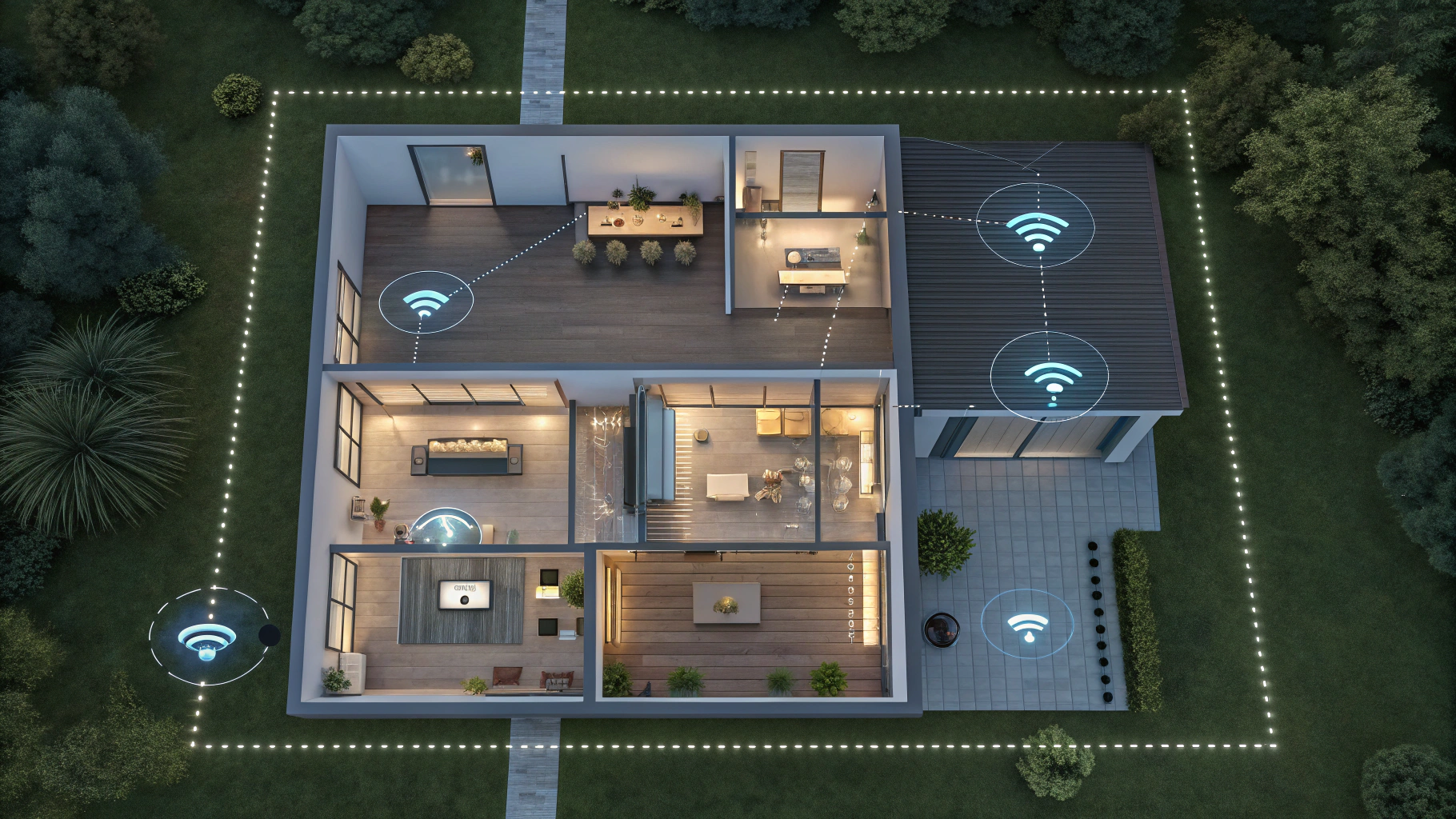Smart tubular motors are rapidly transforming how we automate blinds, shades, and roller systems across residential and commercial buildings. But the real intelligence behind these motors lies in their connectivity—specifically,which wireless protocol they use.
Today, the most common options are WiFi, Zigbee, and the emerging Matter standard. Each brings distinct trade-offs in performance, reliability, scalability, and ecosystem integration.
This article breaks down how these three connectivity protocols compare for tubular motor applications—helping system designers, installers, and buyers make a technically sound choice.
WiFi remains the most familiar and accessible option for smart tubular motors. A WiFi-connected motor links directly to your home or office router (usually 2.4 GHz), allowing control through smartphone apps or cloud services without needing a separate hub.
This direct connection means easy setup and broad compatibility with major smart assistants like Alexa, Google Home, or Apple Home via manufacturer apps. For small installations or single-room automation, WiFi motors are often the quickest way to get started.
However, there are important considerations:
*Network load: Each motor becomes a WiFi client, consuming bandwidth and increasing router overhead. In large installations, this can congest your network, especially if cameras, TVs, or other IoT devices share the same 2.4 GHz band.
*Power and heat: WiFi modules use more power, though this is less critical for mains-powered motors.
*Internet dependency: Remote control depends on cloud connectivity. If your internet or router goes down, control may be lost unless the device supports local fallback.
Industry Insight: For homes with reliable, strong WiFi coverage and only a few smart motors, WiFi-based solutions provide convenience and minimal extra hardware. But for large-scale, multi-room installations, WiFi's simplicity can become a scalability bottleneck.

Zigbee is the veteran protocol of the smart-home world—designed specifically for low-power, low-data IoT communication. Rather than connecting every device directly to the router, Zigbee builds a mesh network, where devices relay messages through one another.
This architecture offers several advantages for tubular motor applications:
*Mesh scalability: Each powered Zigbee device (like a motor or smart switch) extends the network, improving coverage across large buildings.
*Local operation: Even if the internet drops, Zigbee hubs can continue to execute automation schedules and commands locally.
*Lightweight traffic: Zigbee minimizes interference with WiFi networks, which can be critical in dense environments with multiple wireless systems.
The trade-off is the need for a Zigbee hub or coordinator, which manages the network. For commercial or multi-floor installations, the added infrastructure pays off in network reliability and performance.
Expert Perspective: Zigbee's maturity, interoperability with platforms like Philips Hue, Tuya, and Aqara, and its proven reliability make it the preferred choice for large-scale or multi-device automation projects.
Matter is the newest and most ambitious smart home protocol—developed by the Connectivity Standards Alliance (CSA), which includes Apple, Google, Amazon, and others. Rather than being a low-level wireless technology like Zigbee, Matter is an interoperability layer built on top of IP-based networks such as WiFi and Thread.
This meansa Matter-enabled tubular motor can work across different ecosystems and voice assistants, without proprietary apps or fragmented control systems.
Key advantages of Matter include:
*Cross-brand compatibility: A Matter-certified motor works with any Matter-compliant controller, regardless of manufacturer.
*Local control: Matter emphasizes local communication when possible, reducing cloud dependency.
*Unified security model: Standardized, certificate-based encryption across all devices.
However, the ecosystem is still young. Matter-compatible tubular motors and controllers are emerging but not yet as widespread as Zigbee products. Thread, one of Matter's underlying mesh transports, also requires compatible routers or border devices.
Industry Insight: If you're designing for future-proofing and multi-brand integration, Matter represents a forward-looking choice. But for immediate deployment, Zigbee may still offer better ecosystem maturity.

|
Feature / Consideration |
WiFi |
Zigbee |
Matter (over WiFi/Thread) |
|
Setup Complexity |
Easiest (no hub) |
Requires hub/coordinator |
Requires Matter controller |
|
Power Consumption |
High |
Very low |
Moderate |
|
Network Type |
Direct router connection |
Mesh network |
IP-based (WiFi or Thread) |
|
Internet Dependency |
High (cloud control) |
Low (local hub control) |
Low (local + cloud) |
|
Scalability |
Limited by WiFi load |
Excellent (mesh) |
Excellent (mesh/IP) |
|
Compatibility |
App and cloud-based |
Ecosystem-specific |
Cross-brand, unified |
|
Availability (2025) |
High |
High |
Moderate (growing) |
|
Best For |
Small installations |
Multi-room or large networks |
Future-proof, multi-brand ecosystems |
When selecting between WiFi, Zigbee, and Matter tubular motors, consider these key factors:
1) Installation Size and Scale
For a few blinds or shades, WiFi motors are simple and cost-effective. For a large building or multi-room project with many devices, Zigbee's mesh reliability or Matter-over-Thread scalability will provide better performance.
2) Network Infrastructure
If your WiFi network is already crowded, avoid adding dozens of WiFi motors. Zigbee and Thread networks are purpose-built for IoT traffic, offloading your main router.
3) Reliability and Local Control
For automation that must work even when the internet is down, Zigbee or Matter (with local control) are superior. They keep schedules and scenes running independently of the cloud.
4) Ecosystem Integration
If you already use Zigbee hubs (like SmartThings or Hubitat), adding Zigbee tubular motors keeps your system unified. For those starting fresh or aiming for multi-brand control, Matter provides the most open path forward.
5) Future-Proofing
Matter is designed to unify the fragmented smart home landscape. Investing in Matter-compatible tubular motors now may reduce the need for future hardware replacements as the standard matures.

Choosing between WiFi, Zigbee, and Matter tubular motors ultimately depends on how and where the motors will be deployed. The following table provides a quick reference for selecting the most suitable protocol based on installation scale, network environment, and control needs.
|
Use Case / Scenario |
Recommended Protocol |
Reasoning and Key Benefits |
|
Small apartment or single-room smart blinds |
WiFi |
Quick setup without a hub, direct app control, works well if only a few devices share the network. |
|
Large home or villa with multiple blinds/shades |
Zigbee |
Mesh network extends range across rooms, minimizes WiFi congestion, reliable even if internet drops. |
|
Commercial building or multi-floor installation |
Zigbee or Matter (Thread) |
Scalable mesh structure supports dozens of motors, stable local operation, easier centralized management. |
|
Mixed-brand smart home (e.g., using Alexa, Google, and Apple devices) |
Matter |
Cross-platform interoperability and consistent user experience across ecosystems. |
|
Remote vacation property requiring cloud access |
WiFi or Matter over WiFi |
Direct internet connectivity enables remote control and monitoring from anywhere. |
|
Network with weak WiFi coverage or thick walls |
Zigbee |
Mesh routing maintains communication where WiFi signals are weak or obstructed. |
|
Future expansion or smart ecosystem integration (lighting, HVAC, security) |
Matter |
Future-proof IP architecture supports unified control and system-level automation. |
|
High-security or enterprise environments |
Zigbee or Matter |
Local communication reduces exposure to external networks, better isolation from public internet traffic. |
Expert Tip:
When planning your automation project, think of connectivity like wiring infrastructure — investing in the right network foundation (hubs, routers, or Thread border devices) ensures long-term scalability and compatibility as new devices and standards evolve.
Looking ahead, when specifying or purchasing smart tubular motors—such as Smart Blinds Motor WiFi, Smart ZigBee Tubular Motor, or Matter Smart Blinds Motor Kit —it's essential to think beyond today's convenience and consider tomorrow's integration landscape.
The smart motor ecosystem is shifting toward a unified, IP-based future. As Matter adoption accelerates and Thread-capable routers become common, we'll likely see tubular motors that can operate across WiFi, Thread, and Ethernet seamlessly—all while maintaining local control and strong encryption. This means fewer proprietary apps, less fragmentation, and simpler setup experiences for both installers and end users.
Manufacturers are also increasingly designing hardware with firmware upgradability and over-the-air update support, enabling motors sold today to gain new compatibility features in the future. For commercial and multi-residence applications, that future-proof flexibility can significantly extend system lifespan and reduce maintenance costs.
From an integrator's perspective, choosing a motor protocol aligned with Matter or IP-based architectures will open the door to broader interoperability with lighting, HVAC, and energy management systems, enabling a cohesive automation strategy rather than isolated device control.
In short, investing with the future in mind—even if your current setup runs on WiFi or Zigbee—ensures your automation infrastructure remains adaptable as smart home standards evolve.

There is no single“best”wireless protocol for every tubular motor application—the ideal choice depends on your installation scale, infrastructure, and long-term vision.
*WiFi motors are great for quick setup and direct cloud control in smaller systems.
*Zigbee motors offer robust, scalable performance for large smart-home or commercial projects.
*Matter motors represent the future—delivering cross-brand compatibility and IP-based flexibility for evolving ecosystems.
As the smart motor market evolves, we can expect to see Matter-over-Thread tubular motors gaining momentum, bridging the gap between Zigbee's reliability and WiFi's universality.
A well-chosen protocol today ensures your automation system remains reliable, responsive, and ready for the connected future.
We are JlECANG, and we have specialized in Linear Motion Technology for over 20 years. We can create a custom, professional solution for your Tubular Blind Motor needs. If you have any questions or need help, we're always here to assist you.
Ф25mm DC tubular motor - Battery Powered
Ф35mm AC Tubular motor-Mechanical Limit
Curtain motor - Built-in WiFi module